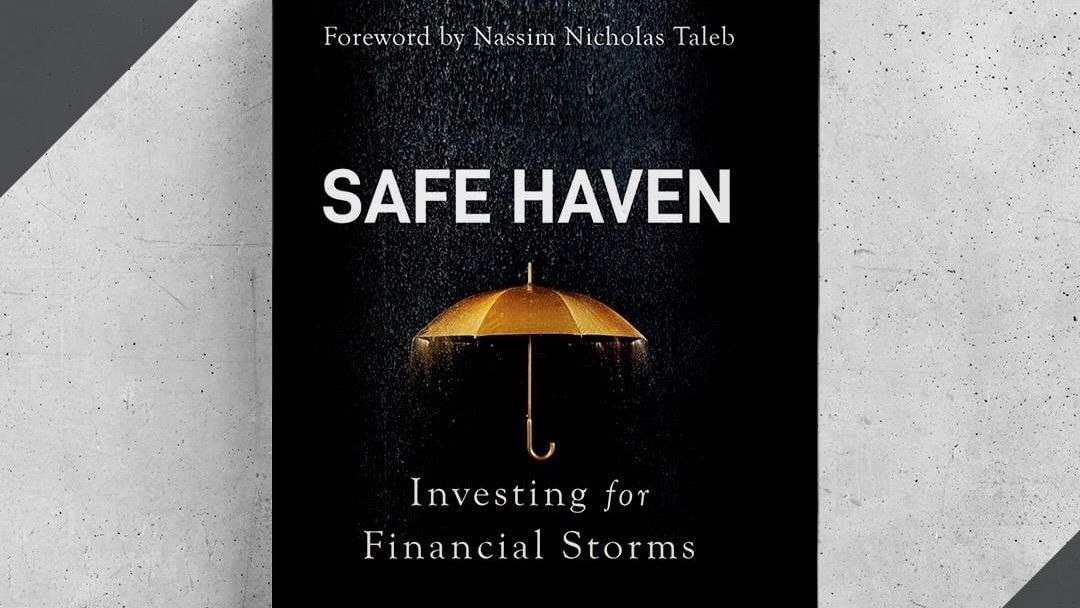Safe Haven by Mark Spitznagel Summary
This book shows you how to mitigate risk in investing.

Key Takeaways
- You must know the limits of your knowledge.
- If you don’t take enough risk, you lose on capital gains. If you take too much risk, you will likely lose much of your investment. Spitznagel argues that many people try to find a happy medium but that can give you the worst of both worlds.
- You have to take risk and hope it works out.
- Cost-effective risk mitigation actually increases your CAGR.
- Spitznagel says that financial academics (modern portfolio theory) do not understand risk mitigation.
- Many finance people use unfalsifiable and cherry-picked market data for their research reports. You must always verify other people’s data.
- All investors are actually risk managers.
- You only get one life, you have to make the right decisions.
- Mark says you can hold 60% of your money on the sideline and then buy in during a big crash. He calls this a store-of-value safe haven. It keeps you from taking big losses and allows you to go in big on huge crashes.
- A store-of-value safe haven should have a low correlation (low sensitivity) to other assets. So if other markets crash, the safe haven does not. It thus provides both a cushion and “dry powder” should a crash take place. It is basically a matter of diluting risk.
- Safe havens are not a particular asset type. They can be anything—they may or may not have similar traits. One safe haven today may not be one in the future and one from the past may not be one today.
- You need to always use safe havens. You cannot switch in (when times are bad) and out (when times are good) of safe assets because that would require a crystal ball and nobody has a crystal ball.
- There are 3 common risk mitigation strategies that are terrible: (1) hopeful haven, (2) unsafe haven, and (3) diworsifier haven. The hopeful haven cohort put their money into speculative assets and hopes they go up. The unsafe haven cohort put their money in things that “always go up” (until they don’t), like the S&P 500 or real estate. The diworsifier haven cohort buys dozens or hundreds of assets to mitigate their downside risk (without realizing they are mitigating their upside potential).
- “The diworsifier haven is without a doubt the most common form of safe haven imposter. It is pervasive throughout almost all investment portfolios. This is because diversification as a risk‐mitigation strategy is the central pillar to the central paradigm in all of investing: modern portfolio theory.”
- As Buffett himself has said, “Wide diversification is only required when investors do not understand what they are doing.”
- The Sharpe ratio is useless.
- Volatility does not equal risk.
- Risk mitigation efforts must be portfolio dependent. There is no one-size-fits-all in risk management.
- Institutional investors must abide by the dogma of financial academia and traditional finance (modern portfolio theory) because if you mess up, it is much better to die with the herd than take a risk on your own. Also, financial advisors have company policy and rules they must follow. It is the same with doctors, if they use the status quo treatment on a patient, they cannot be sued if anything goes wrong. But if they use a treatment that is not status quo but they think will enhance the patient’s prognosis, they can be held personally liable.
Chapter 1
At War with Luck
It is very important to do what others will not do—not just to know what others do not know. It is also important to know what you do not know.
Safe haven = risk mitigation
If you don’t take enough risk, you lose on capital gains. If you take too much risk, you will likely lose much of your investment. Mark argues that many people try to find a happy medium but that can be bad—it can give you the worst of both worlds.
- The answer: you have to take risk and hope it works out.
Cost-effective risk mitigation actually increases CAGR.
Mark says that financial academics (modern portfolio theory) do not understand risk mitigation.
Many finance people use unfalsifiable and cherry-picked market data for their research reports. You must always verify other people’s data. If something doesn't seem right or if it’s too good to be true, check it.
Investors are actually risk managers.
Chapter 2
Nature's Admonition
This is a technical chapter. Read the physical book.
In Nietzsche’s thus spoke Zarathustra, a demon comes and says you will have to live your life over exactly how it was. Are you glad or sad? The point is you only get one life. You need to be correct. You cannot just do Bayesian thinking, be incorrect, but then say “well my probabilities were correct but it just didn’t go my way.” You only get one life, so you HAVE to get it right.
Chapter 3
The Eternal Return
Mark says you can hold 60% of your money on the sideline and then buy-in during a big crash. He calls this a store-of-value safe haven. It keeps you from taking big losses and allows you to go in big on huge crashes.
The insurance safe haven is technical (read in book).
Chapter 4
A Taxonomy
Mark poses the question: Is there a general safe haven asset type? Do all safe havens have an underlying trait or are they all different? Or do they all inherently have to be different? The answer is that they can be anything—they may or may not have similar traits and one safe haven today may not be one in the future. And one from the past may not be one today.
A store-of-value safe haven should have a low correlation (low sensitivity) to other assets. So if other markets crash, the safe haven does not. It thus provides both a cushion and “dry powder” should a crash take place. It is basically a matter of diluting risk.
“The alpha payoff is like the store‐of‐value, only its correlation is now expected to be negative. This means that, specifically during a crash, it is expected to generate a positive return of some sort. Think of it as the flight to quality dynamics that we tend to associate with safe havens, causing them to appreciate in a crash.”
“We saw in Part One the two extremes of the spectrum of safe haven payoffs: the store‐of‐value and the insurance payoff. In the middle of that spectrum, I will add another data point, what I call the “alpha” safe haven payoff.”
Figure 2 shows the heuristics of the 3 safe haven assets. Every investor would choose the caricature of the alpha safe haven because it gives them normal returns in a normal market but higher returns in a bear market—but finding this asset in real life is difficult if not impossible.
“This looks somewhat like the intended performance of systematic trend‐following commodity trading advisor (CTA) strategies, global macro and long‐volatility strategies, or even gold. And it also looks like an “at‐the‐money put” on the SPX—that you're actually paid to own.”
“The insurance prototype on the right makes an explosive profit of 1,000% in the crash bucket and loses 100% in every other year (whenever the SPX isn't down by 15% or more).”
- Insurance makes the most (by far) in a crash but every year there is no crash you lose money.
Risk mitigation Irony
“The big problem with safe havens is they aren't necessarily all that cost‐effective. Just because an asset or strategy made the safe haven cut, doesn't necessarily mean that you would have been glad to have it in your portfolio.”
“Safe havens can be exceedingly costly, so much so that, as a cure, they can be worse than the disease. Nietzsche said it best: “Whoever fights monsters should see to it that in the process he does not become a monster.” This is the risk‐mitigation irony (and fate loves irony).”
You need to always use safe havens. You cannot switch in (when times are bad) and out (when times are good) of safe assets because that would require a crystal ball and NOBODY has a crystal ball.
Figure 3 shows safe haven traps (they look like safe havens but ruin your portfolio):
A lot of these safe haven traps are marketing ideas from financial institutions. They cherry-pick information and take historical examples to show why their way is right. But analyzing past crashes does not mean you can accurately predict future crashes.
To continue the metaphor, an unsafe haven is like jumping out of an airplane with the conviction that you can fly.
The unsafe haven is just plain myopic, extrapolated naïveté based on a story that is concocted to fit that performance.
The dogma of diversification
“Our third variety of safe haven imposters, the diworsifier haven is without a doubt the most common form of safe haven imposter. It is pervasive throughout almost all investment portfolios. This is because diversification as a risk‐mitigation strategy is the central pillar to the central paradigm in all of investing: modern portfolio theory.”
“The diworsifier haven is named after what Peter Lynch referred to as diworsification. The thinking goes like this: Fill your portfolio with things that don't all move around together and, as a result, your portfolio will move around less. And thanks to this diversification, your portfolio's performance in a crash will likely fare somewhat better than the broad market (which, by the way, is also pretty diversified). Best of all, your volatility will be lowered. But so, too, will your returns, as this diversification comes at a pretty price in the form of underperformance costs during non-crash periods (by the same logic as its outperformance during crashes). Over time, the “diworsification” ends up costing more than it saved (hence the cute name).”
“But as long as your average returns are lowered less than your volatility (meaning your dreaded Sharpe ratio is raised), something purposeful is presumed to have happened."
"This is so wrong on so many levels—not a terribly insightful comment by me. As Buffett himself has said, “Wide diversification is only required when investors do not understand what they are doing.” What's more, diversification is “a confession that you don't really understand the businesses that you own.”
“The estimation of volatility is conflated as risk. “(A little technical‐speak interjection: Just as volatility is the square root of the average squared return, the geometric average is the exponential of the average log‐return; only the latter has real economic meaning, as we saw in Chapter 2. The former is a mathematically convenient proxy for the latter. It works okay in some dice games, but not in the markets.) And diversification never tends to be as great (nor correlations as low) as it appears.”
“Because diversification lowers returns in the name of higher Sharpe ratios, investors who use this strategy but aren't content with those lower returns are then forced to apply leverage in hopes of raising them back up. Doing so adds a different kind of risk by magnifying the portfolio's sensitivity to errors in those spurious correlation estimates. To be fair, most investors are constrained (or perhaps too wise) to use leverage like this in practice, and instead live with their lower risk‐mitigated returns.”
“Diversification, then, is either about potentially less risk in exchange for less return, or it is about moving from systematic or concentration risk to levered model risk. It is not a free lunch. There is no free lunch (though cost‐effective risk mitigation does seem to look like getting paid to eat lunch).”
Chapter 6
Bold Conjectures
The whole can be more than the sum of its parts.
Risk mitigation efforts must be portfolio dependent. There is no one-size-fits-all in risk management.
Mark says that the store-of-value and the alpha safe havens do not work well. The insurance safe haven is the best.
- But Mark says that the best safe havens are extremely rare in the real world, so you may have to settle for “good” safe havens like store-of-value and alpha.
Institutional investors must abide by the dogma of financial academia and traditional finance (modern portfolio theory) because if you mess up, it is much better to die with the herd than take a risk on your own. Also, financial advisors have company policy and rules they must follow. It is the same with doctors, if they use the status quo treatment on a patient, they cannot be sued if anything goes wrong. But if they use a treatment that is not status quo but they think will enhance the patient’s prognosis, they can be held personally liable.
Analysis of specific safe havens:
Store-of-Value (Cash)
- The 3 month US Treasury bill is the best example of cash.
- This does not improve portfolio CAGR, so it's not the best safe haven but not bad.
- These are the traditional go-to “safety” asset
- Treasury bills, notes, and bonds are all the same, they just specify time to maturity.
- Conclusion: the three‐month Treasury, 10‐year Treasury note, and 20‐year bond are all drags on portfolio performance. They’re not bad but not great. The long term (20 years) is WAY better than 3 month bonds.
Alpha
- Momentum trading long or short.
- Mark found that this safe haven was a major drag on portfolio performance and had insufficient downside protection.
- Conclusion: All alpha strategies are all poor performers.
Insurance
- Gold is the best example of insurance.
- Gold is perhaps first and foremost thought of as a hedge against inflation. But it is actually a very noisy hedge against inflation.
- It is mostly (even almost entirely) tied to movements in real interest rates. (When inflation goes up faster than nominal interest rates, real rates go down, pushing up gold prices. But was it inflation or real rates? It's a chicken or the egg problem.) And you can think of low real rates as lessening the opportunity cost burden of the zero yield of gold.
- The net portfolio effect of gold is positive (+0.3%). But there is more to the story so we must dive deeper.
- We know that gold is all about investors' expectations of its value. It has no yield and is completely unproductive in its role as a financial asset. As such, it has no intrinsic economic value. It is for that reason impossible to fundamentally value.
- In either case, gold's payoff has become increasingly flattened over time, or more alpha‐like or even store‐of‐value‐like; this has resulted in lower standalone arithmetic average returns for gold, which have in turn resulted in lower net portfolio effects: from +1.5% in the first period to –1.1% in the second, and to –0.1% in the third.
- Conclusion: Gold may only be a hopeful haven. It is not proven to be better than other methods (even store of value or alpha). In the 70’s gold was a cost-effective safe haven but ever since the 80’s it has lost its safe haven attributes.
Cryptocurrencies
- At first glance, they look like unsafe havens—or hopeful havens at best.
- Mark argues that cryptocurrencies are fiat currencies because they are not backed by anything.
The difference between strategic and tactical safe havens. Strategic safe havens can be bought and held. Tactical safe havens require you to have a crystal ball and predict markets. Most of the assets Mark covered are actually hybrid strategic and tactical safe havens. Meaning you trade them a little bit. The real world isn’t as clear cut.
Modern finance is a pseudoscience. Not falsifiable.



Comments ()